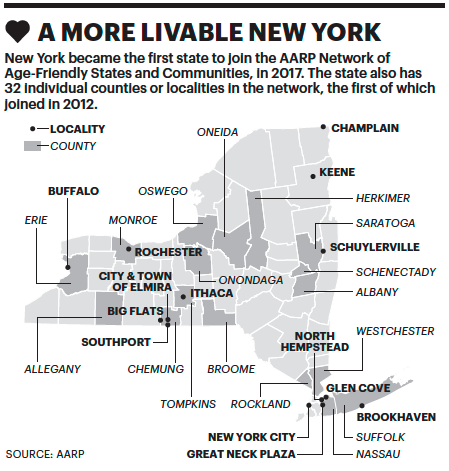AARP Hearing Center

For 32 years, Rochester-area resident Amy Scaramuzzino needed friends to drag her across beaches on a blanket to avoid her wheelchair getting stuck in the sand.
So she was thrilled last August when she came upon a turquoise mat that stretched down Ontario Beach, near her home north of Rochester. It reached close to the water’s edge.
Finally, Scaramuzzino thought, she and her friends who also use wheelchairs could enjoy the beach on their own.
“I want to be out there, you know?” says Scaramuzzino, 59, a retired high school English teacher. “You do miss it. I mean, just — you know — to sit out there and have the sand on your feet.”

Scaramuzzino was injured in a car crash in her 20s.
The wheel-friendly beach mat is part of Monroe County’s efforts to make the community more age-friendly. And it’s not just for those in wheelchairs: After all, it helps people with strollers and walkers — and anyone else who has trouble navigating sand.
Monroe County is one of 856 communities — including 32 in New York — in the AARP Network of Age-Friendly States and Communities. In 2017, New York became the first state to join the network, which now has 11 states plus the U.S. Virgin Islands.
As network members, state and local governments work with community partners and residents to make neighborhoods more walkable, public transportation more accessible, housing more affordable, and parks and other public spaces more welcoming. AARP helps guide communities through all stages of their age-friendly work, from surveying residents about their needs to devising and carrying out a community action plan.
“We want our community to be a place where people can age well,” says Leanne Rorick, codirector of the Monroe County Aging Alliance, which helped develop and implement the county’s age-friendly action plan.
The focus comes as New York and other states and local governments eye their rapidly aging populations. Nationwide, 1 in every 5 Americans will be 65 or older by 2030.
“I think the general consensus is that we’re not prepared for what that’s going to look like, and we need to be doing the work now,” says Robyn Haberman, associate state director of community engagement for AARP New York.
Rochester resident Jill Dimino, 79, has taken advantage of computer literacy classes at her local YMCA. Dimino, a retired assistant to a state senator, says she has appreciated learning how to detect scam emails, craft Google searches and decipher search results.
Now others at the YMCA ask her to look up information for them. “They’re learning something, I’m learning something, so it’s a good thing,” Dimino says.
In the Southern Tier’s Chemung County, which in 2012 became one of the first New York communities to join the AARP network, the city of Elmira is getting more bike lanes and new apartments for lower-income residents in downtown, within a short walk of two grocery stores, a farmers market and city hall.
Evanna C. Koska, chair of the Chemung County Department of Aging and Long Term Care advisory council, says the curb cuts in Elmira-area sidewalks help people of all ages, whether using wheelchairs or strollers.
“Anything that benefits older people benefits youngsters, too,” Koska says.
In Monroe County, officials plan to focus more on helping older residents remain socially connected — something Scaramuzzino appreciates. The beach mat will help her socialize outdoors — a key to her emotional well-being as she grows older. Scaramuzzino would also like to use a publicly accessible beach wheelchair.
“That,” she says, “would be freakin’ phenomenal.”
Katherine Shaver has worked as a journalist for more than 30 years, including 26 years at The Washington Post.
More on Livable Communities































































